On the last day of our stay in village Anakao in the southwest of Madagascar my friend Sneža and I went again to the beach restaurant close to our hotel where we had also had our lunches the previous two days. On the first day the lunch was great, on the second – not so much, but since it was the low season we did not have much choice, so we went again to the same place. However, on this day, the ordered fish was really good, so I was both full and content.
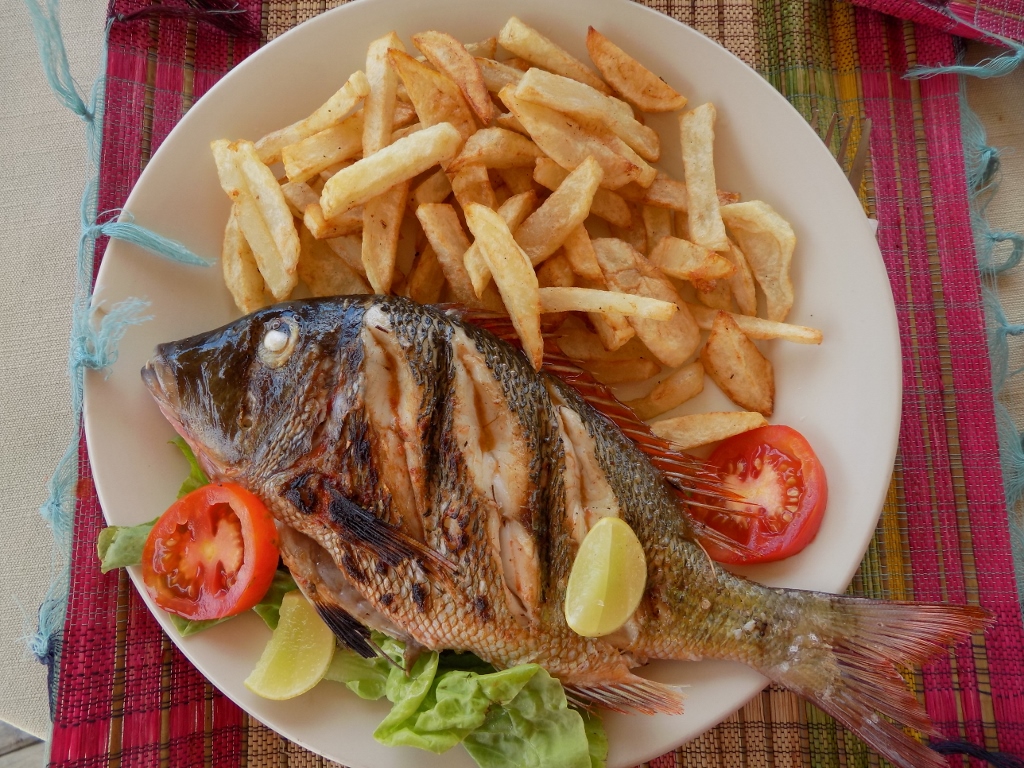 Lunch in Anakao
Lunch in Anakao
Regardless of these daily variations, the restaurant was actually quite good, simple, but in a great place. On the other hand, it did seem to me that this was the only restaurant open during the low season, since we regularly met there a Malagasy couple with whom we came here by the speedboat from Tulear, while they were staying at a hotel that was farther away from ours in relation to the restaurant.
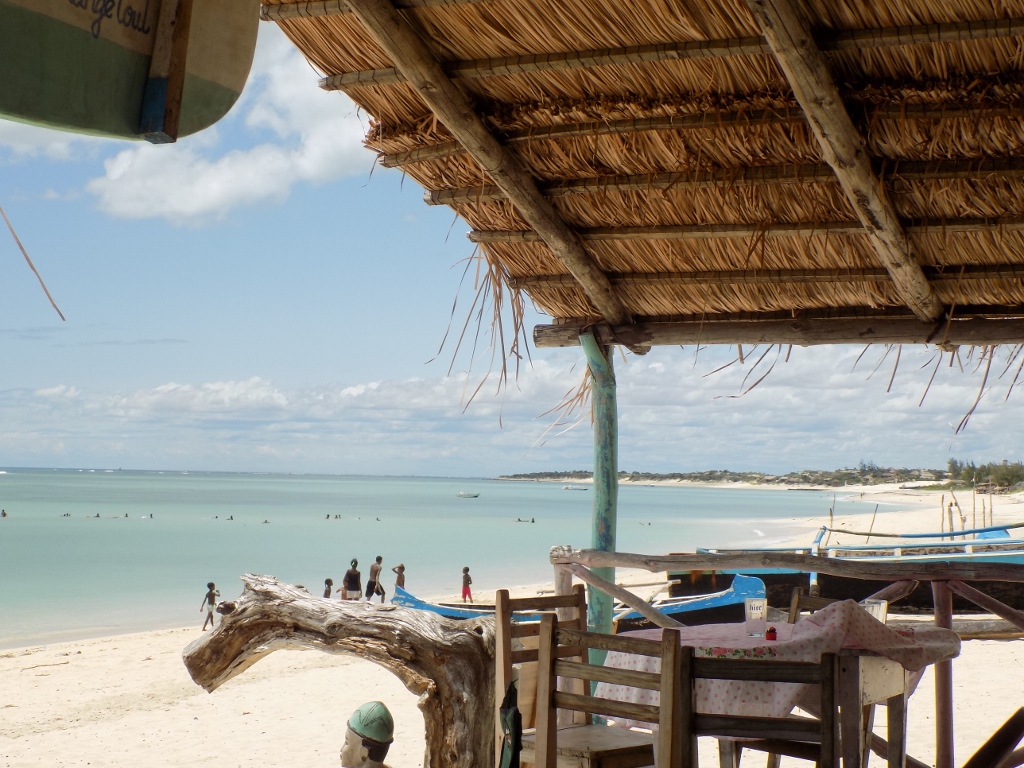 Terrace of the restaurant in Anakao where we had our lunches
Terrace of the restaurant in Anakao where we had our lunches
Having finished the lunch we returned to the beach beds close to our bungalow, but after the refreshing swim and short drying, I could no longer stand the heat I was surrounded with, so I withdrew to my room. There I opened windows on several sides of the bungalow and thus I managed to be cooled down a little by the draft, although it still felt very hot.
When it felt as if the heat had diminished a little, I decided to go for a walk in the surroundings of the hotel. Namely, since we stayed here only for 3-4 days, I did not want to move too much away from the beach, but I was inspired to go for this walk thanks to an “invitation” by birds. From time to time I could hear their wonderful songs and it was clear to me that many of them were “hiding” in the woods behind the bungalows.
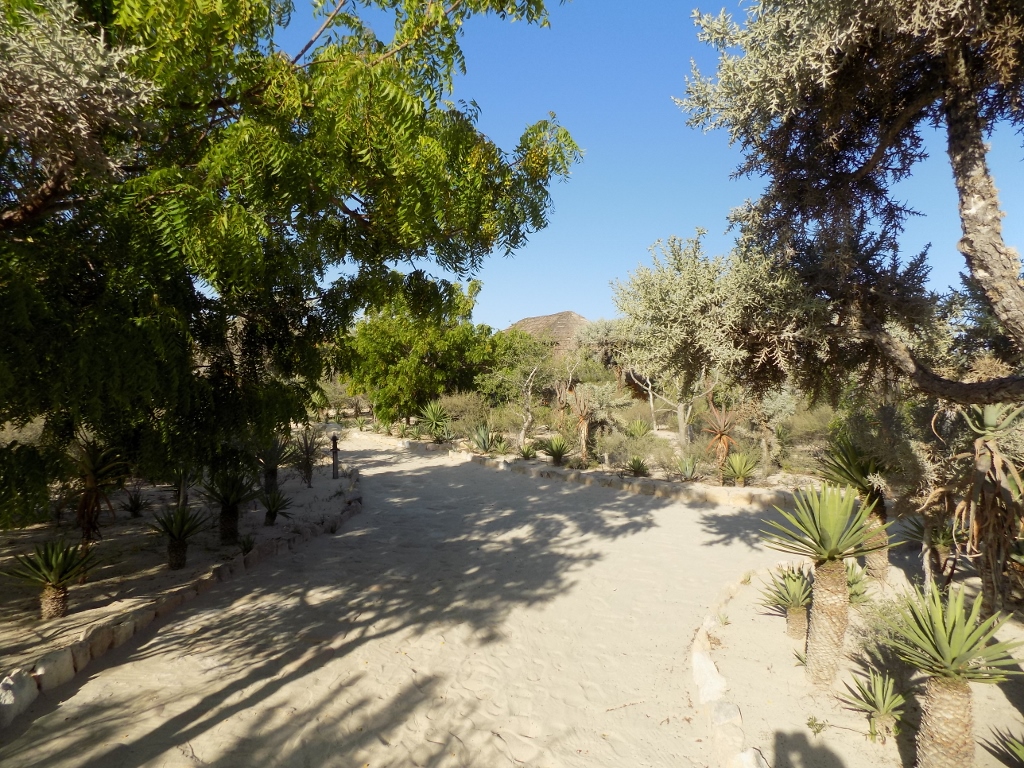 Path in the front section of the hotel’s property
Path in the front section of the hotel’s property
Along the way I also saw a cute small lizard.
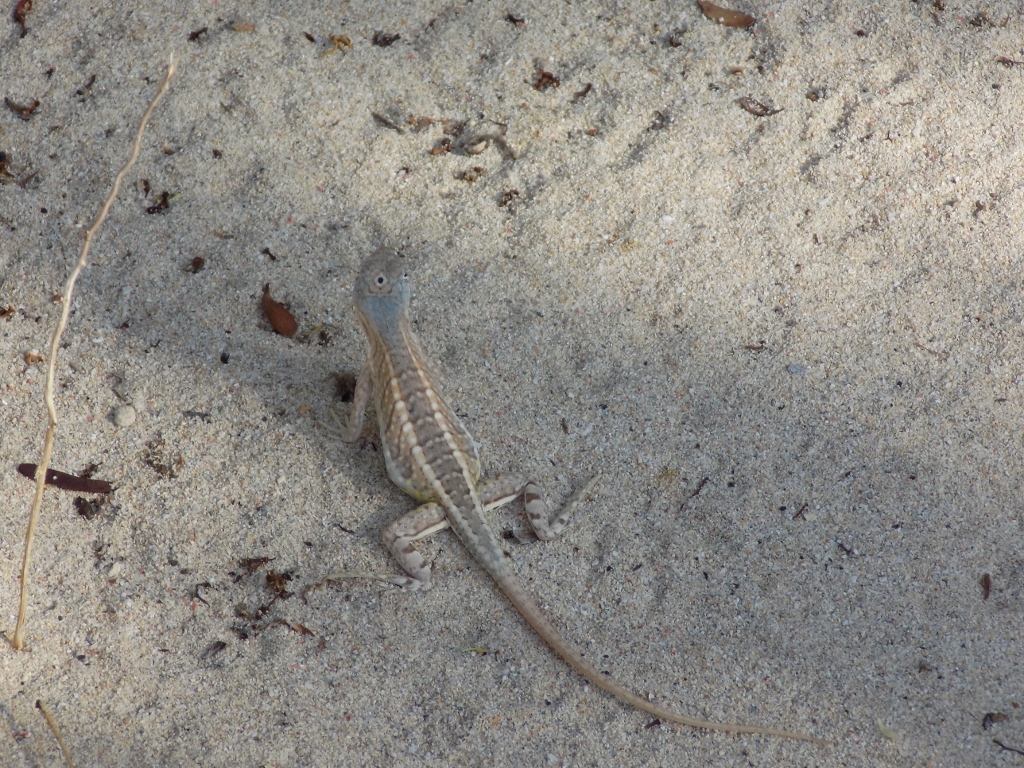 Lizard close to the beach in Anakao
Lizard close to the beach in Anakao
And then I saw several different birds.
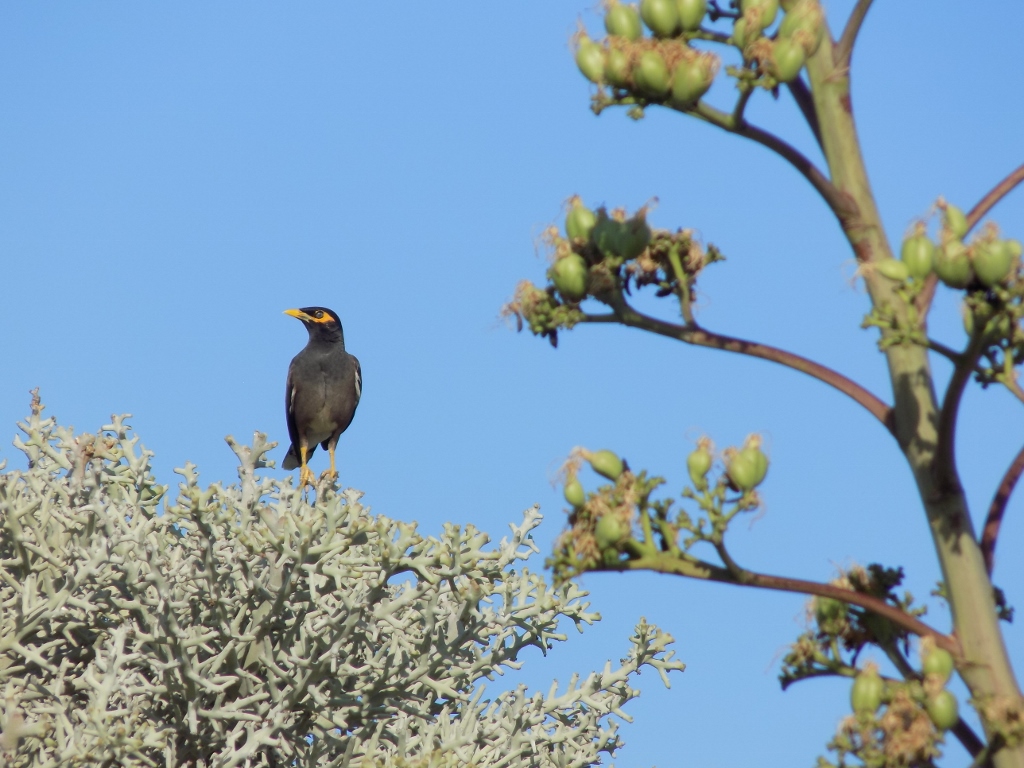 Common myna (Acridotheres tristis)
Common myna (Acridotheres tristis)
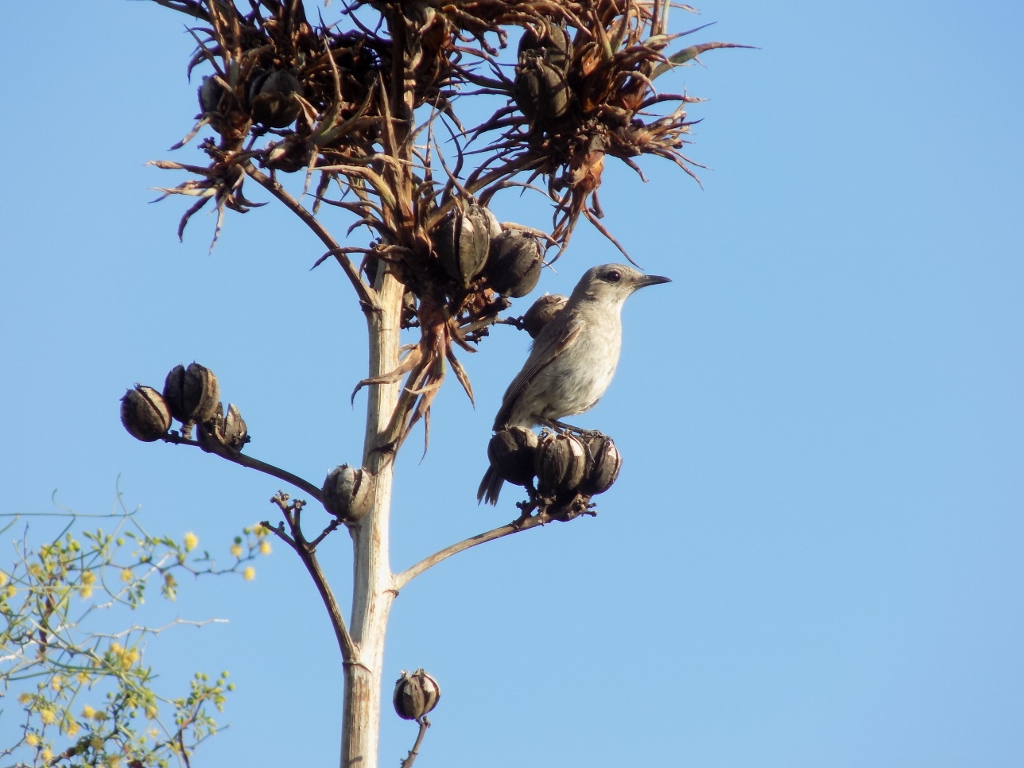 I think this is a Madagascan starling (Hartlaubius auratus)
I think this is a Madagascan starling (Hartlaubius auratus)
And then I left the woods behind the hotel and went to the perimeter of the village, since my intention was to go back to the beach, so I did not want to move too much away from the hotel. There I first saw a school.
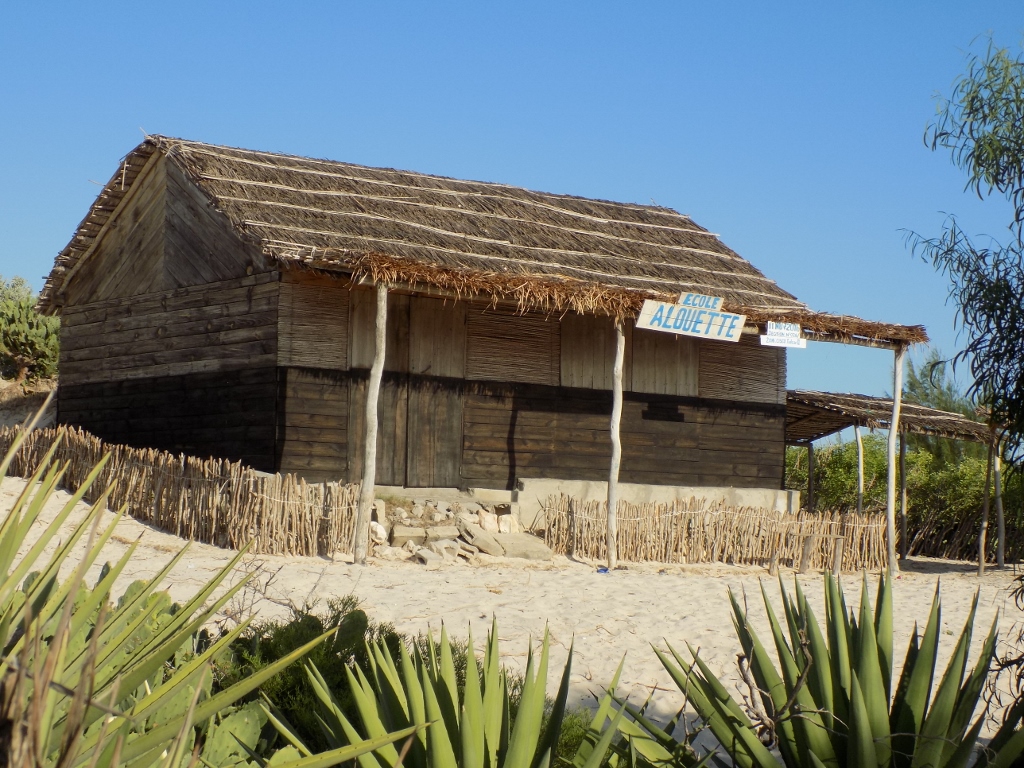 School building in Anakao
School building in Anakao
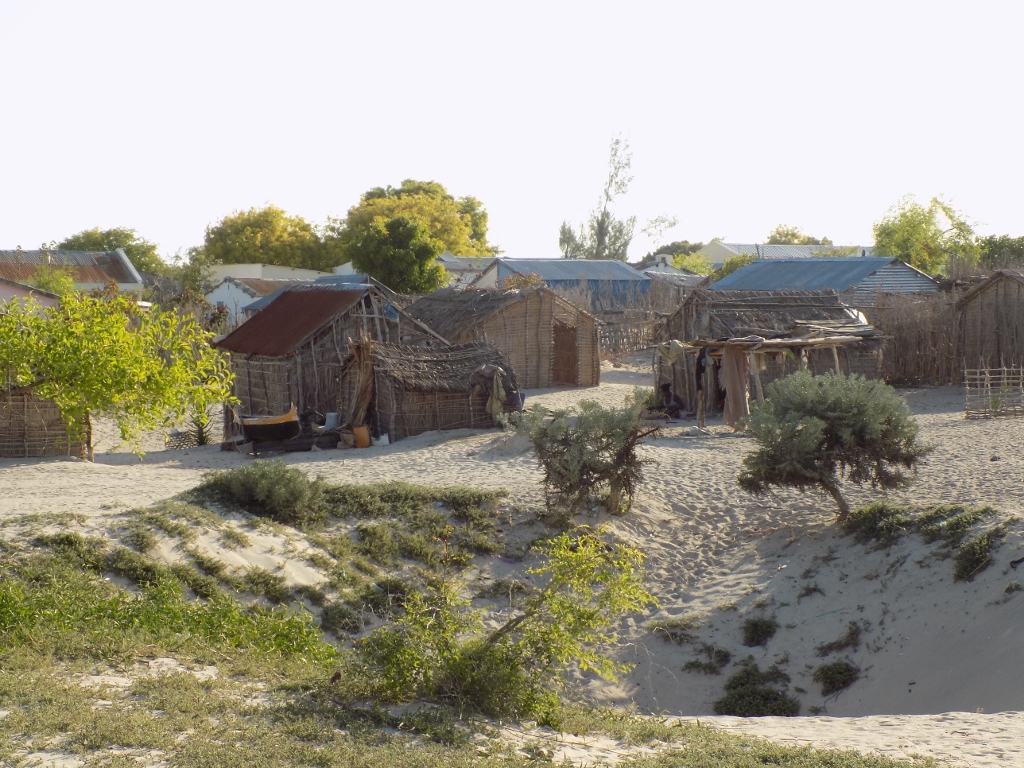 Village Anakao
Village Anakao
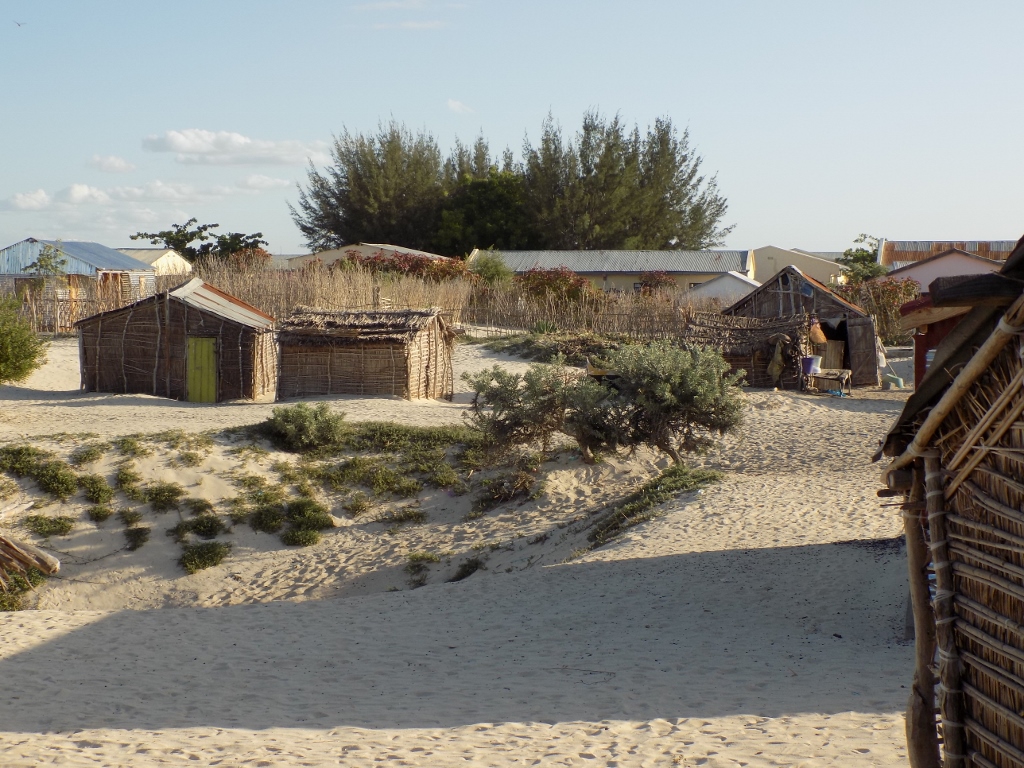 Village Anakao
Village Anakao
While I was standing in a clearing taking photos of the village, I was approached by three girls. They were led by one who was particularly keen on having her photos taken and I gladly obliged. And yet, I did not like the way this young girl stroke her pose. She, like her friends, was probably around 11-12 years old and she put some small plastic ball between her teeth trying to be „seductive.“ I don’t know where she has seen that, who her paragon is and what her ambitions are at her young age, but I actually disliked it all so much that I don’t want to show the photo to anyone.
I actually prefer to show a detail I noticed on a village house. Note the lock that can be seen on the door jamb. The house seems very easy to knock down and yet there is a lock to make sure that the door can be safely secured.
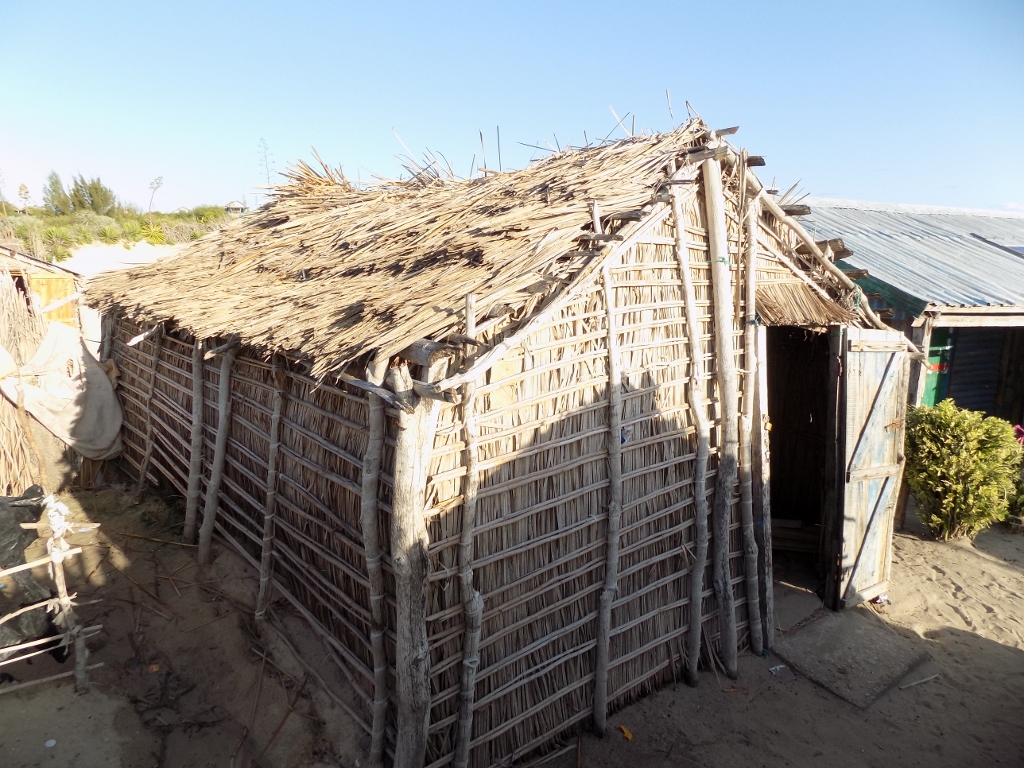 House with a lock
House with a lock
Soon I returned to the beach where I found Sneža, so I went into the water again, but in the meantime the wind had picked up quite a lot and the waves were big enough that I did not stay there for too long. I was additionally discouraged from entering and exiting from the ocean. It was the time of the low tide, the water had receded significantly and it was necessary to walk relatively a lot through shallow water in order to get to a deeper section, while I could see different waste on the beach – in addition to pieces of clothes and similar items, there were also some rusty old cans and I also noticed the bottom of a broken glass with a few pointy ends where there used to be the wall of the glass. In other words, very unsettling. Both my friend and I did well, we did not hurt ourselves and did not step on anything that could be seen on the beach, but that certainly spoiled the overall impression. Although the employees of our hotel regularly collected the washed-up garbage putting it into a large woven basket they pulled along the section of the beach that followed the line of the bungalows, I’m afraid that the beautiful beaches of this world will become more like landfills as the time goes by.
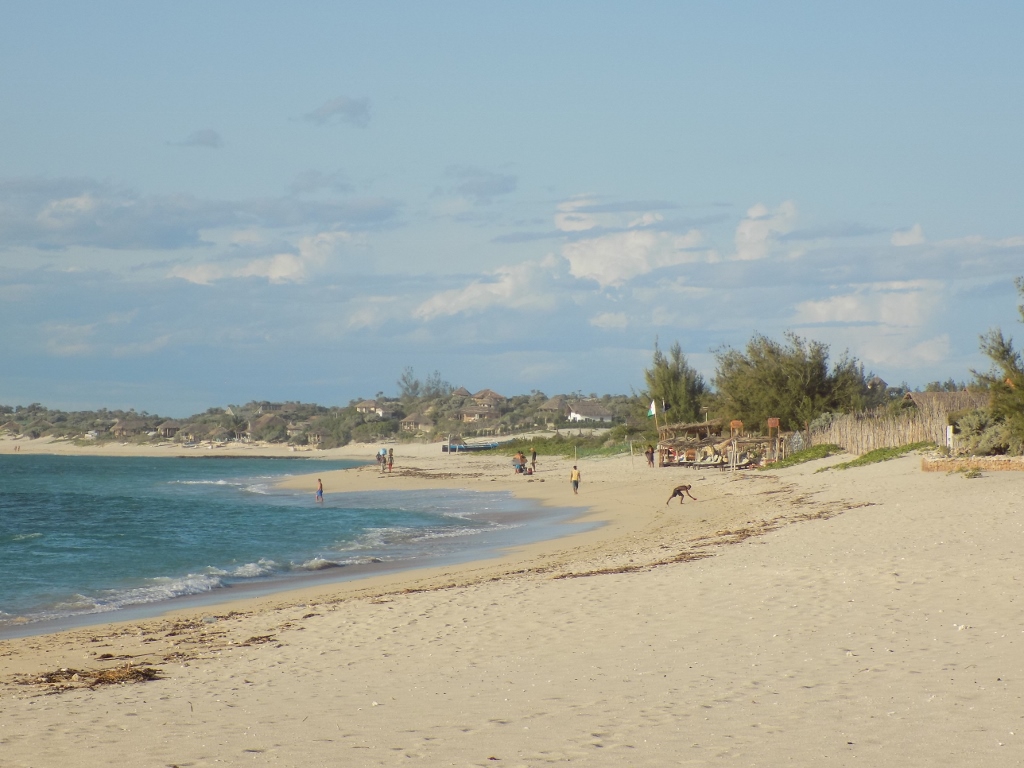 Beach in Anakao
Beach in Anakao
For this reason I spent most of the late afternoon lying or sitting on the beach bed and watching the events around me.
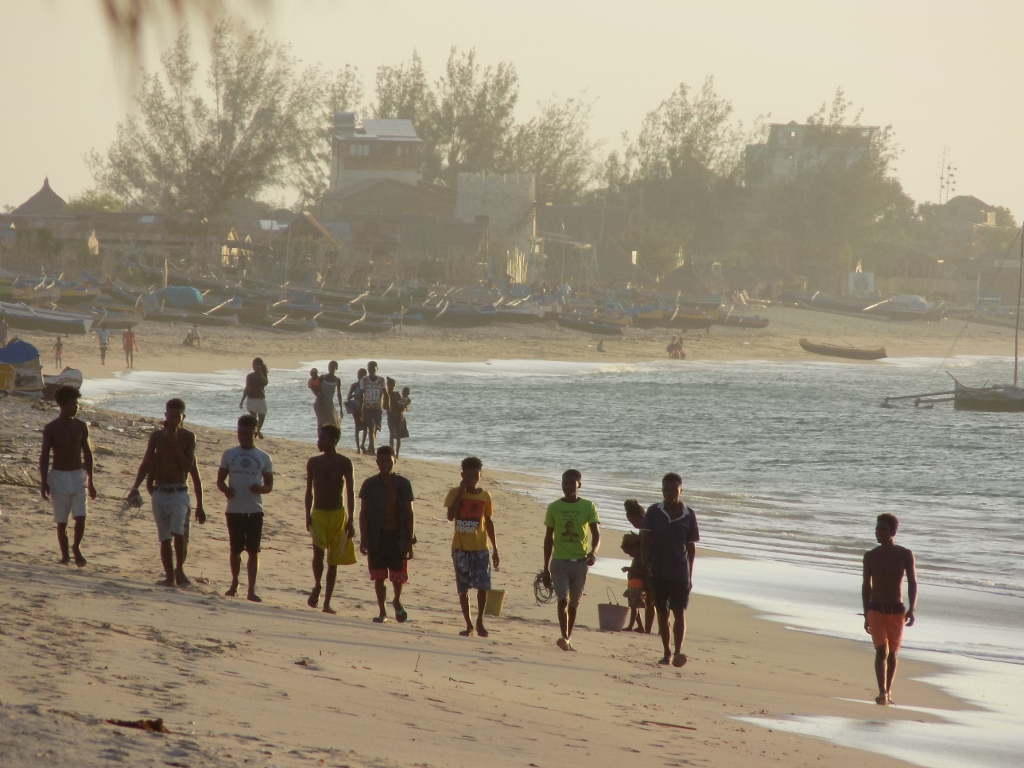 Late afternoon stroll along the beach
Late afternoon stroll along the beach
Needless to say, I enjoyed again in the sunset.

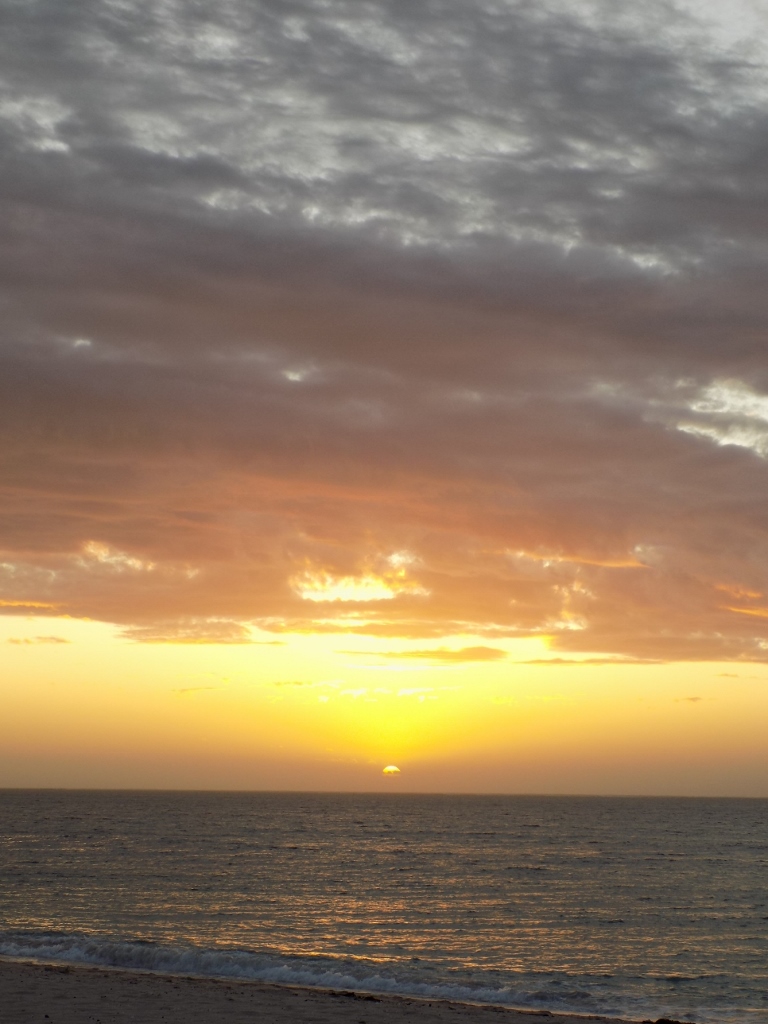 The sunset above the Indian Ocean
The sunset above the Indian Ocean
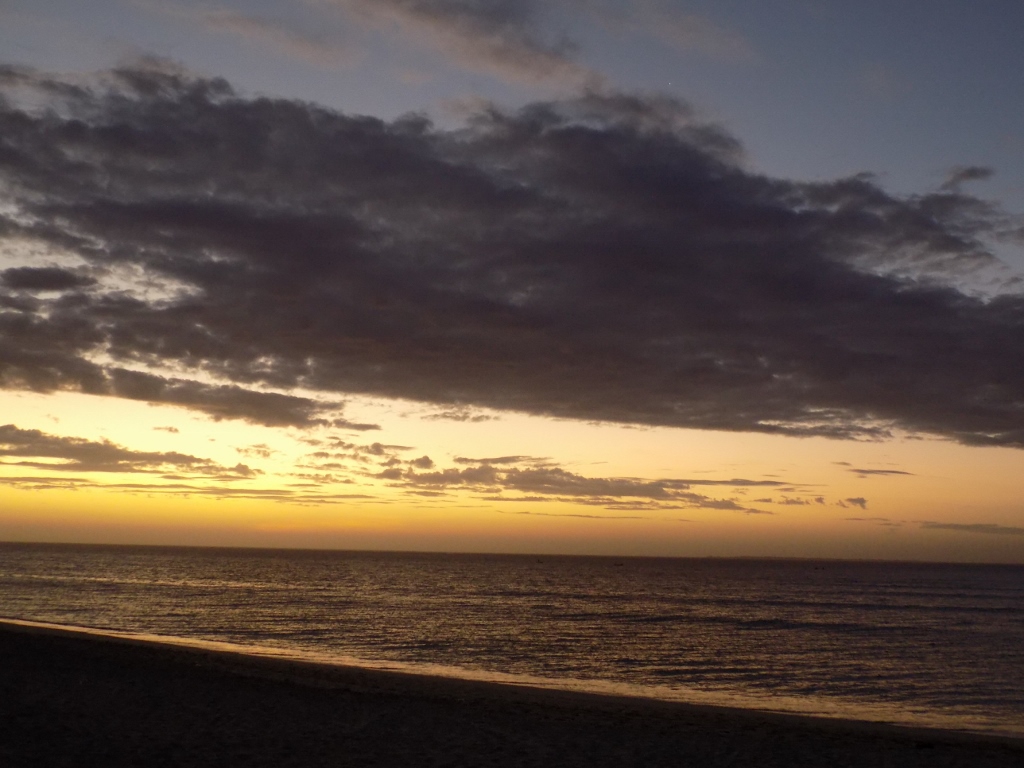 The sunset above the Indian Ocean
The sunset above the Indian Ocean
The last morning I woke up even before the alarm on my phone. The first reason was that the previous night I had fallen asleep already around 9.30 pm (there was still electricity, since it is switched off at 10 pm), so I did have my proper eight hours. The other reason was that this morning I heard a lot of birds singing in the vicinity. They certainly must have sung the previous days, but apparently I had slept through that.
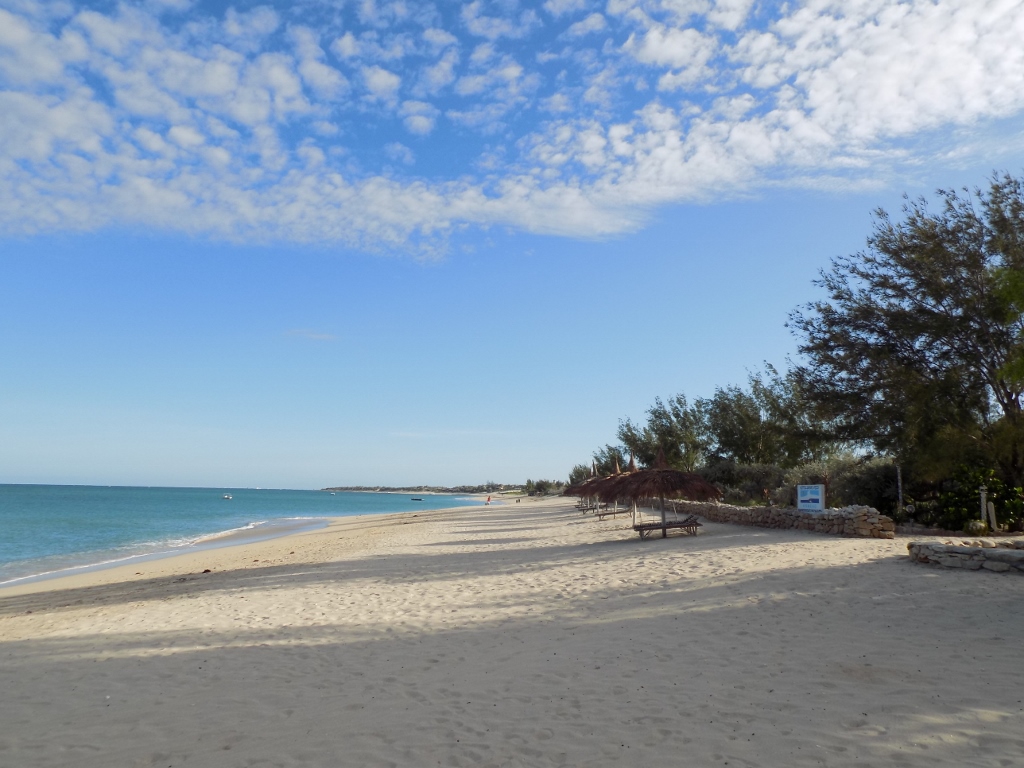 Morning in Anakao
Morning in Anakao
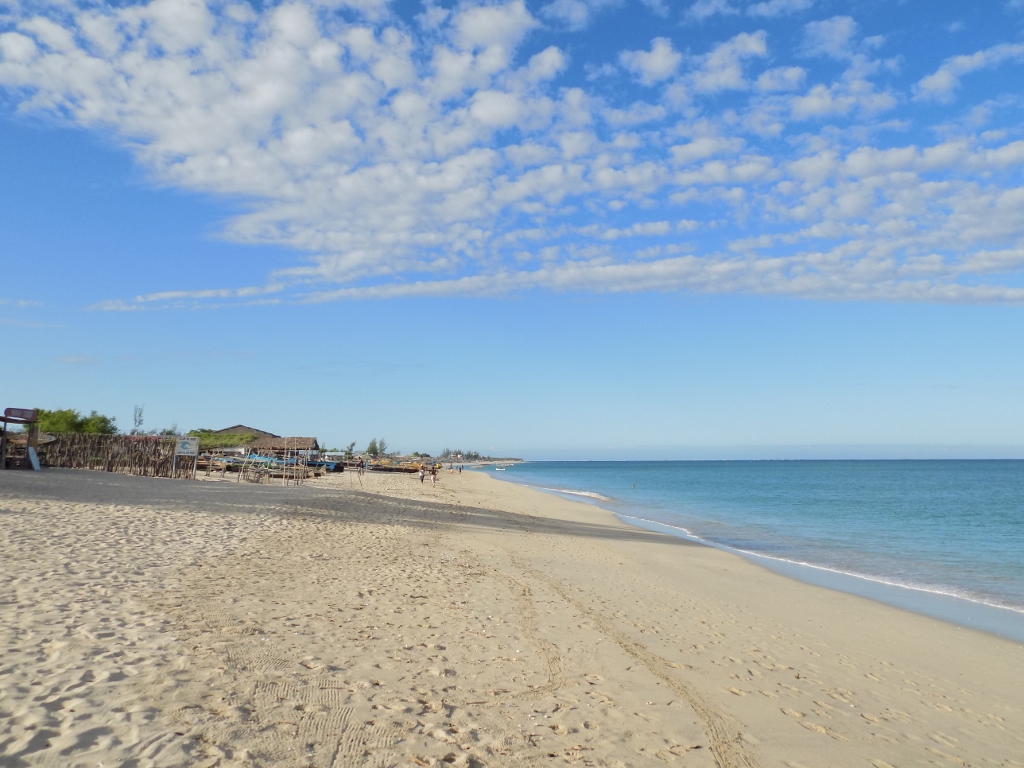 Morning in Anakao
Morning in Anakao
After breakfast, we sat for a while in the shade, while I enjoyed in the view at the calm ocean which was almost without a wave on that morning.
Right on time, the speedboat of our transportation company came already filled with passengers, we climbed in and the guys from our hotel put our backpacks in. Again I loved this type of transportation from one place to another and I thoroughly enjoyed it. As if I had obtained two for the price of one – both transportation to the destination of choice and an excursion in the form of a ride across the sea. This was all certainly true, but I was fully aware of that and felt happy.
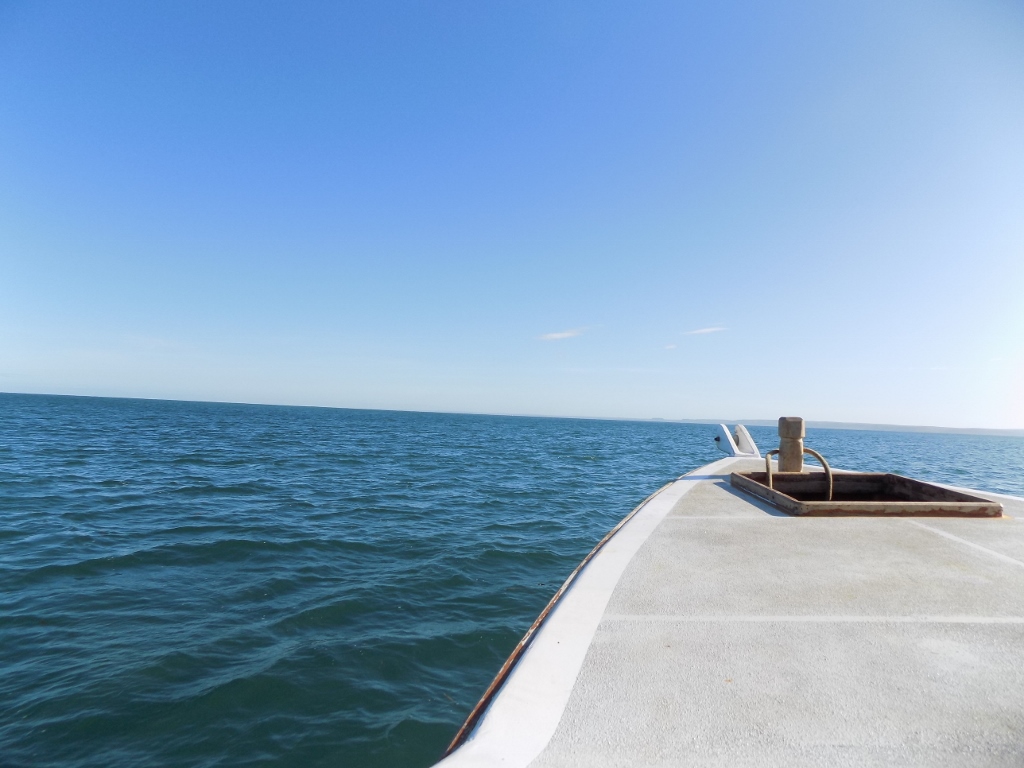 Public transportation between Anakao and Tulear
Public transportation between Anakao and Tulear
When we reached Tulear, the low tide was even more intensive in comparison to a few days earlier, so the carts pulled by zebus had to venture even deeper into the water.
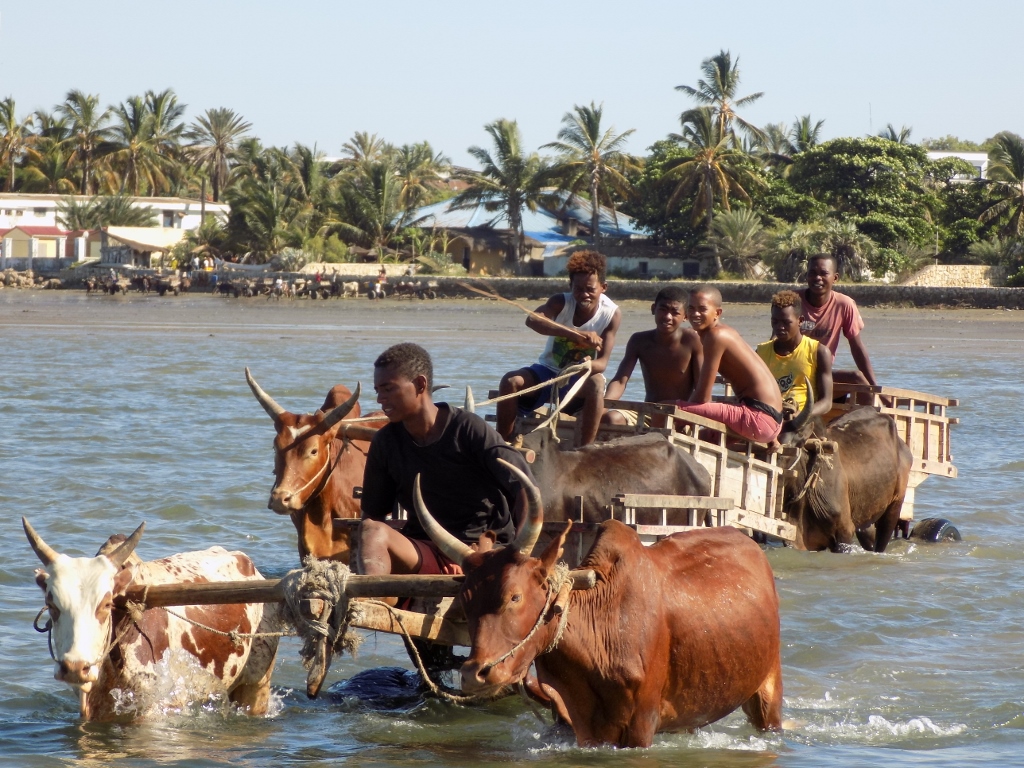 Zebu-pulled carts are coming to collect passengers and luggage
Zebu-pulled carts are coming to collect passengers and luggage
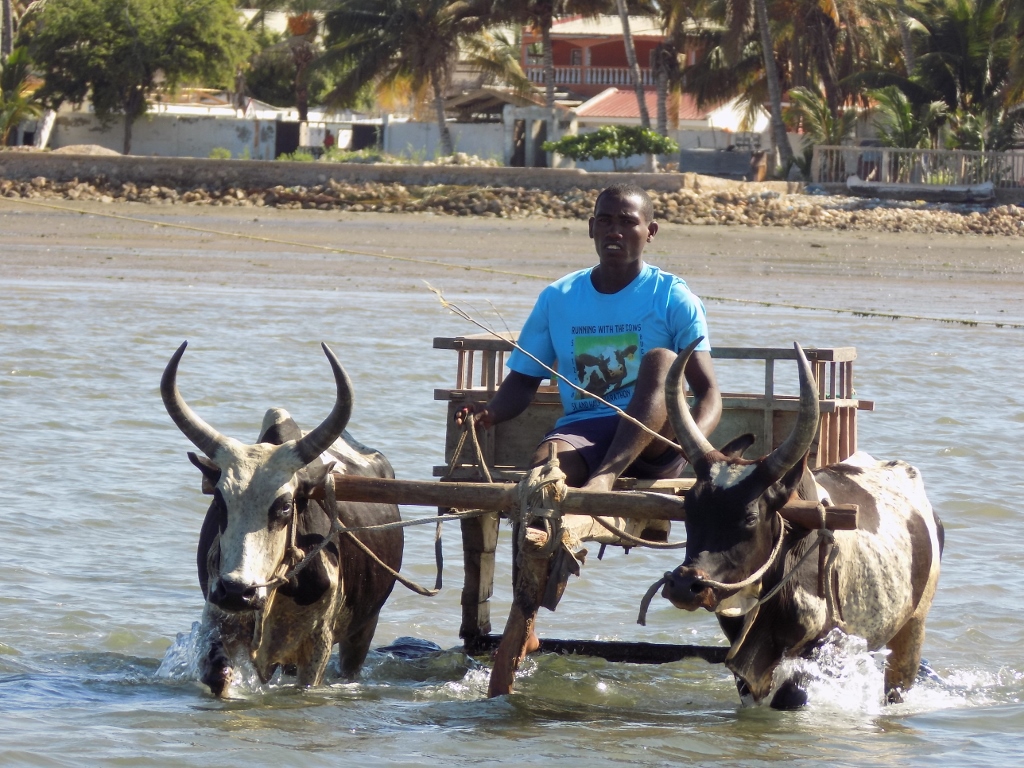 Another cart coming to collect passengers and luggage
Another cart coming to collect passengers and luggage
I would have gladly filmed my ride again, but this one seemed more wobbly, so I hanged tightly to the railing on which I was sitting, too.
When we disembarked from the cart, we were immediately met by several taxi drivers and we opted for one since we had to go to the airport. As I often do in similar situations, I agreed with the taxi driver to take us to the place we wanted, but also to make a few stops along the way so that the two of us could do some final errands. Thus we stopped at the artisanal market in order to buy a couple of gifts, then we went to the post office and mailed a few postcards (which reached the designated addresses a couple of weeks later) and we also went to a supermarket in order to buy some water and snacks for the continuation of our trip. After all of that, we were taken to the airport.
We got there a little earlier and the plane from Tulear was a little late, but it all went perfectly well. Namely, I was a little worried about this flight, since I had often read that internal flights on Madagascar tend to be late a lot. For us, it was important to get to Antananarivo as soon as possible, because we were to transfer by car directly from there to the next destination and this requires over three hours.
At the airport in Antananarivo we were met by Rija, our driver, since we were continuing with our road trip around Madagascar. Along with him, we were met by rain that was quite intensive at the time. During our journey I often mentioned how lucky we were with the weather and now Rija told us that we were very lucky indeed. Namely, four days earlier when he had left us in front of the office of our speedboat transportation company, Rija headed back to Antananarivo. Now he told us that already after 30 km it started to rain and it did not stop at all, so there, even now when we landed it was still going on. I told him jokingly that he should not worry, because we had arrived, and the rain would stop in half an hour or so. We started driving towards our next destination and while we were moving very slowly along the bypass that took us through city streets of some parts of the capital until a better road had been made, it really stopped raining and during most of the rest of our trip it did not rain at all. Moreover, on a couple of occasions we could discern the Sun through thin clouds.
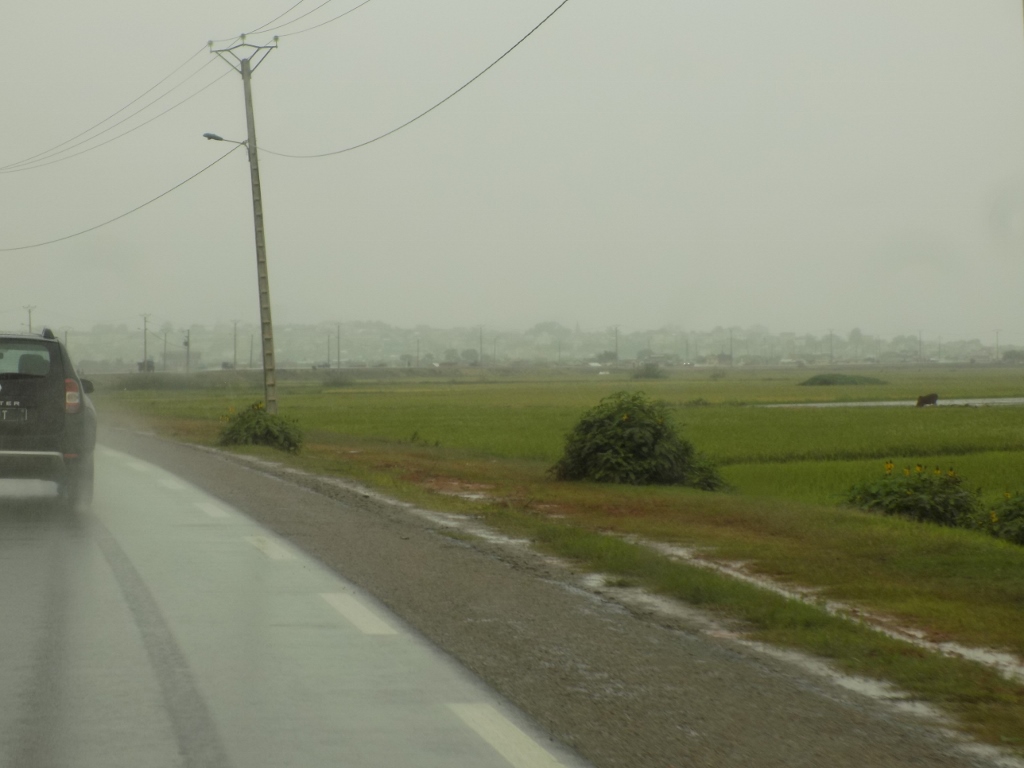 Rain in Antananarivo
Rain in Antananarivo
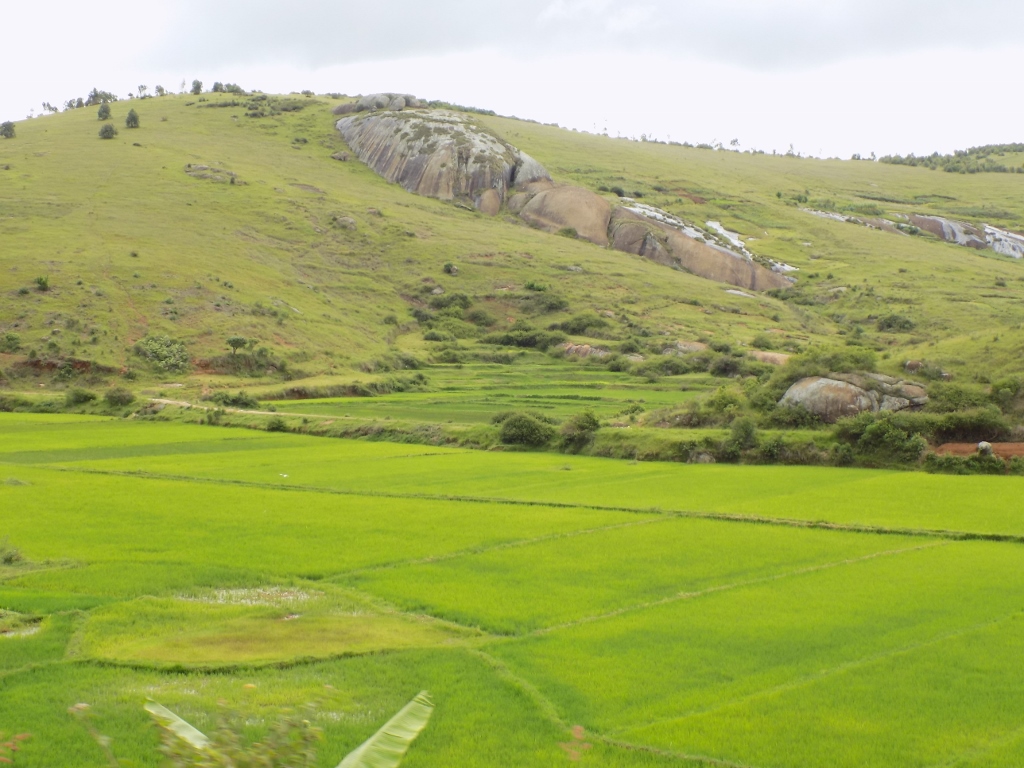 Amazing green colour of young rice
Amazing green colour of young rice
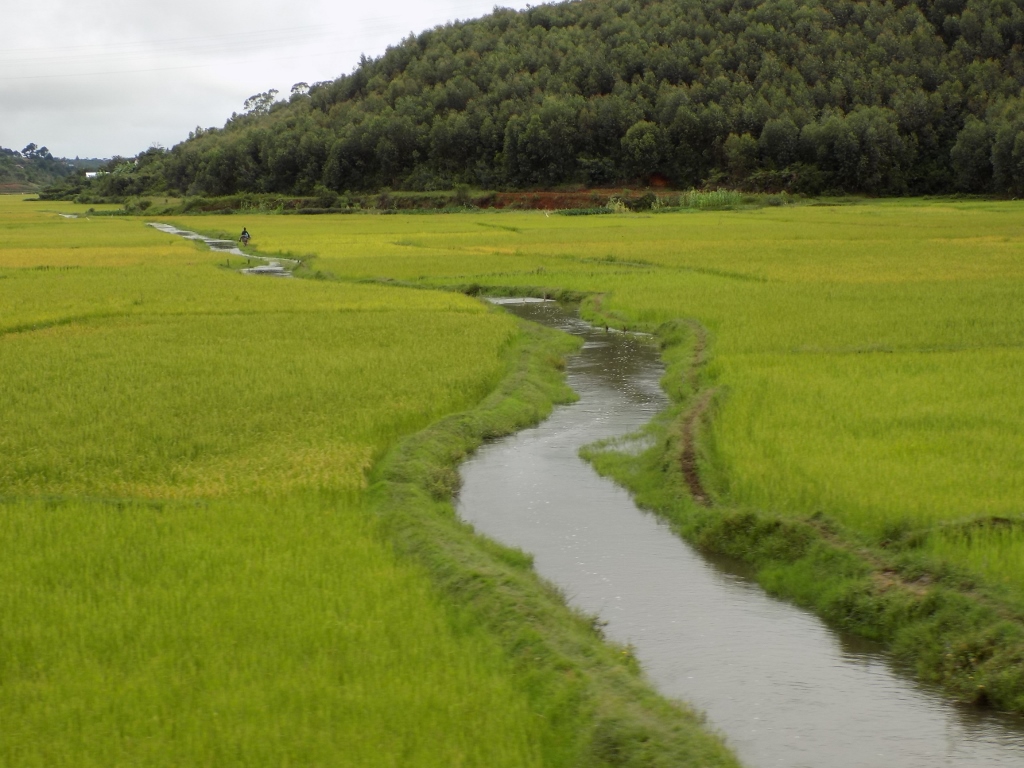 Rice fields east of Antananarivo
Rice fields east of Antananarivo
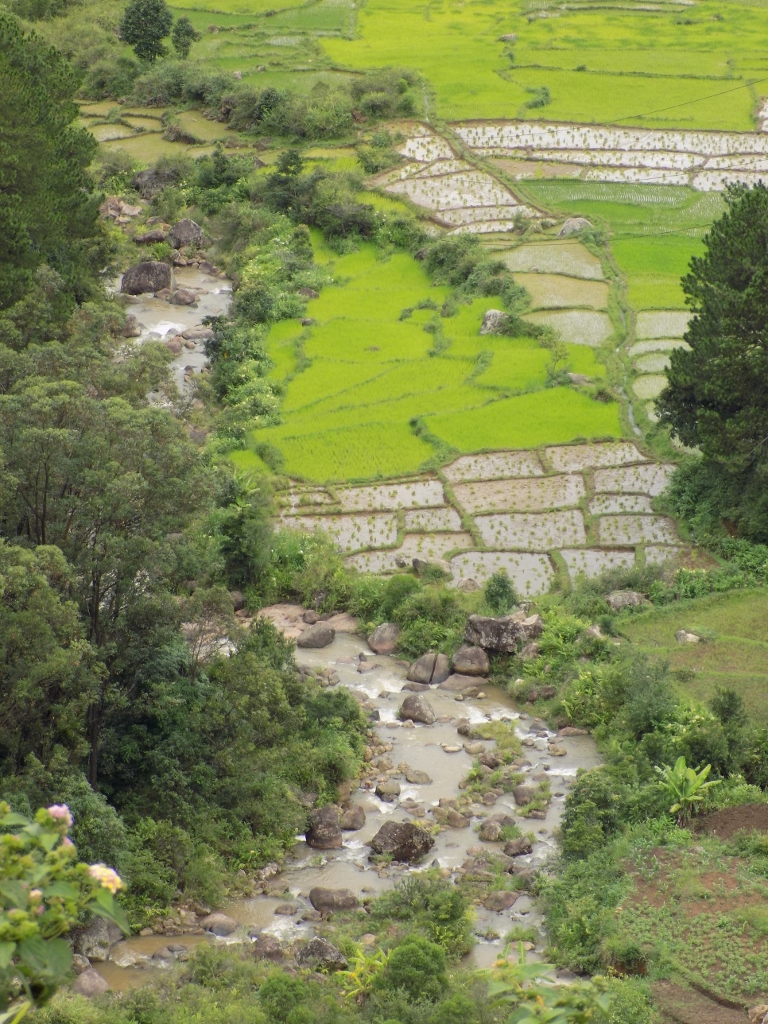 Rice fields east of Antananarivo
Rice fields east of Antananarivo
In addition to passing by numerous rice fields, the road that leads eastwards from the capital of Madagascar, Antananarivo, also passes beside large eucalyptus forests. Madagascar has a huge problem of deforestation. This seriously endangers the autochthonous flora and fauna, creates conditions for erosion and washing out of the fertile soil levels, etc. Apparently, some kind of very partial solution has been found in the planting of eucalyptus trees that do not originate in Madagascar, but they grow fast and they can be used for producing charred coal.
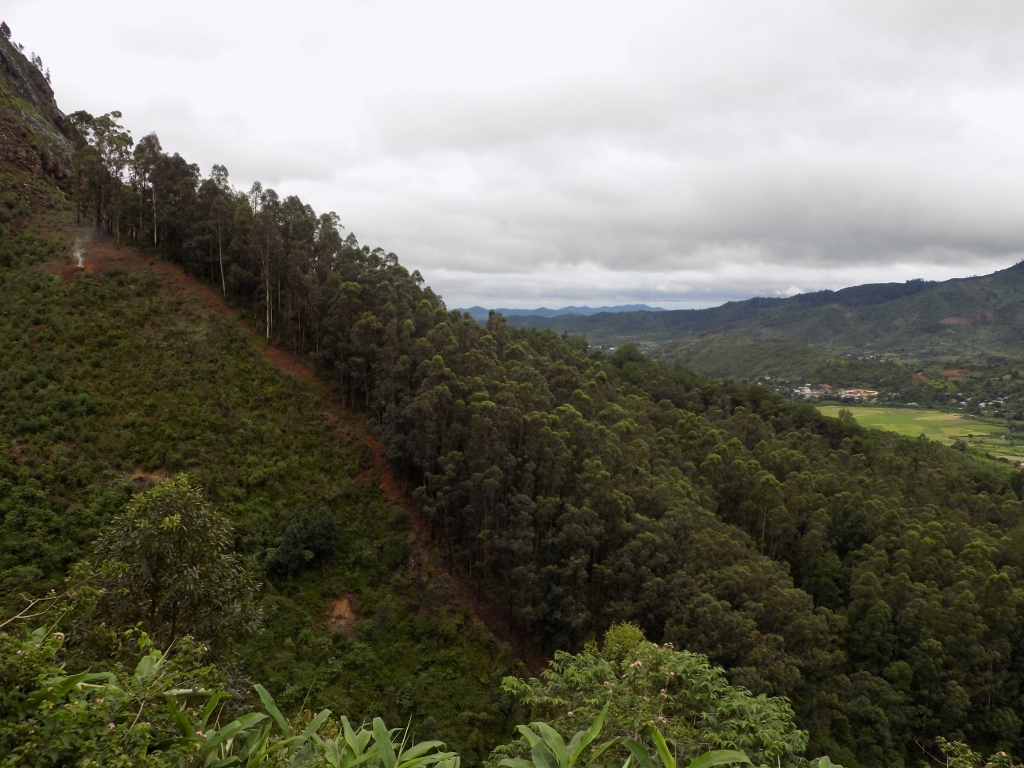 Eucalyptus forests
Eucalyptus forests
Still, bearing in mind that our next destination was the place called Andasibe which is located in the middle of a rainforest zone, where it rains almost constantly (during all seasons), no wonder that it started to rain again at some point.
On the other hand, our biggest problem in this case was a long stop that we had to make along the road. Namely, there was an accident, I don’t know if it was a traffic accident or a truck with a trailer just broke down, but we had to stay in one place together with an incredibly large number of trucks for at least one hour. The problem is that this National Road (RN2) connects the capital which is the biggest city on Madagascar and the second largest city on the island which is at the same time their biggest port in the east of the country. This means that all the transportation of goods, as well as humans, is conducted by this road which is not very wide and has a lot of curves.
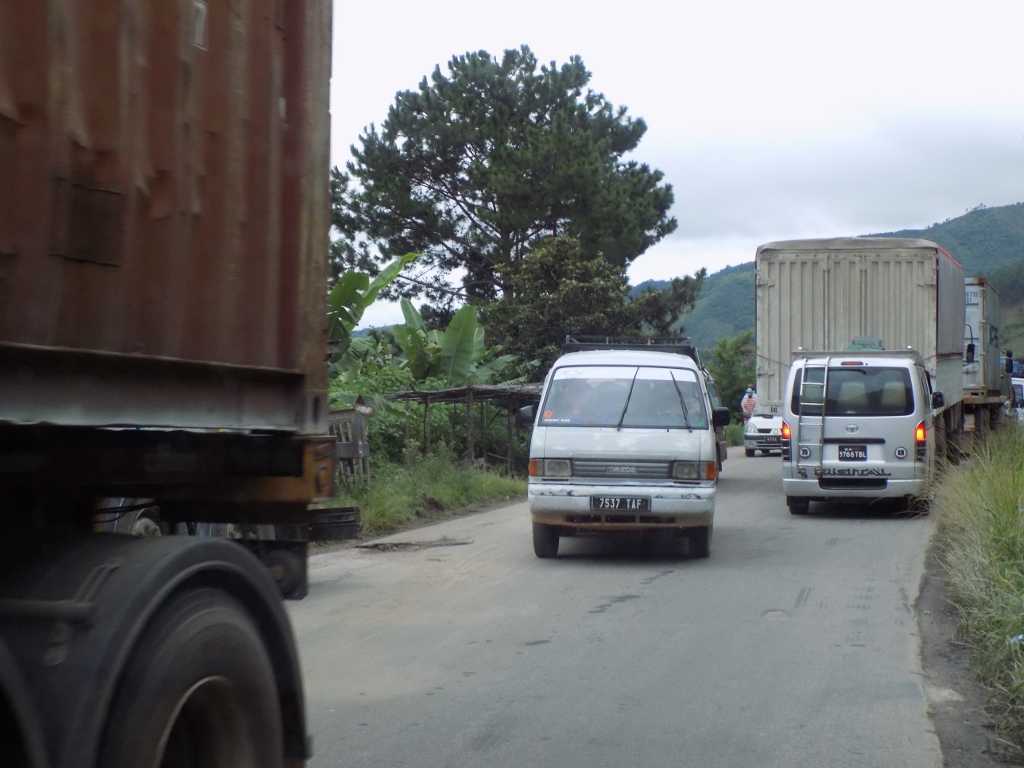 While we are standing, the traffic in the opposite direction is slowly allowed to pass
While we are standing, the traffic in the opposite direction is slowly allowed to pass
Because of the slow passage through the narrow side streets of Antananarivo and this down time on the road, it became dark even before we arrived in Andasibe and then it started to rain heavily. This, however, did not stop Rija from driving quite swiftly – I did not know whether I should admire him or be in panic. As I was sitting in the passenger seat, it was quite clear to me that he was driving perfectly, but still all the time I had the impression I would not be driving more than 20 km/h. Luckily it was not me driving, but Rija, so we arrived at the hotel sufficiently early to order dinner which was very tasty. That evening I took chicken in coconut sauce with ginger, but I was just far too hungry to be bothered with taking photo of the food.
Although the internet forecast threatened with some serious rain, the following morning we were met by dry weather and there were a lot of blue patches in the sky. For that day, we had the plan to go for a walk around rainforest and for a photographic and visual hunting of local wild animals, so it suited us perfectly to have the dry weather. And so it was – the entire day.
Still, to start with it was nice to wake up, get out of the room and face the peaceful hotel complex at which we were staying. Again, we were the only guests.
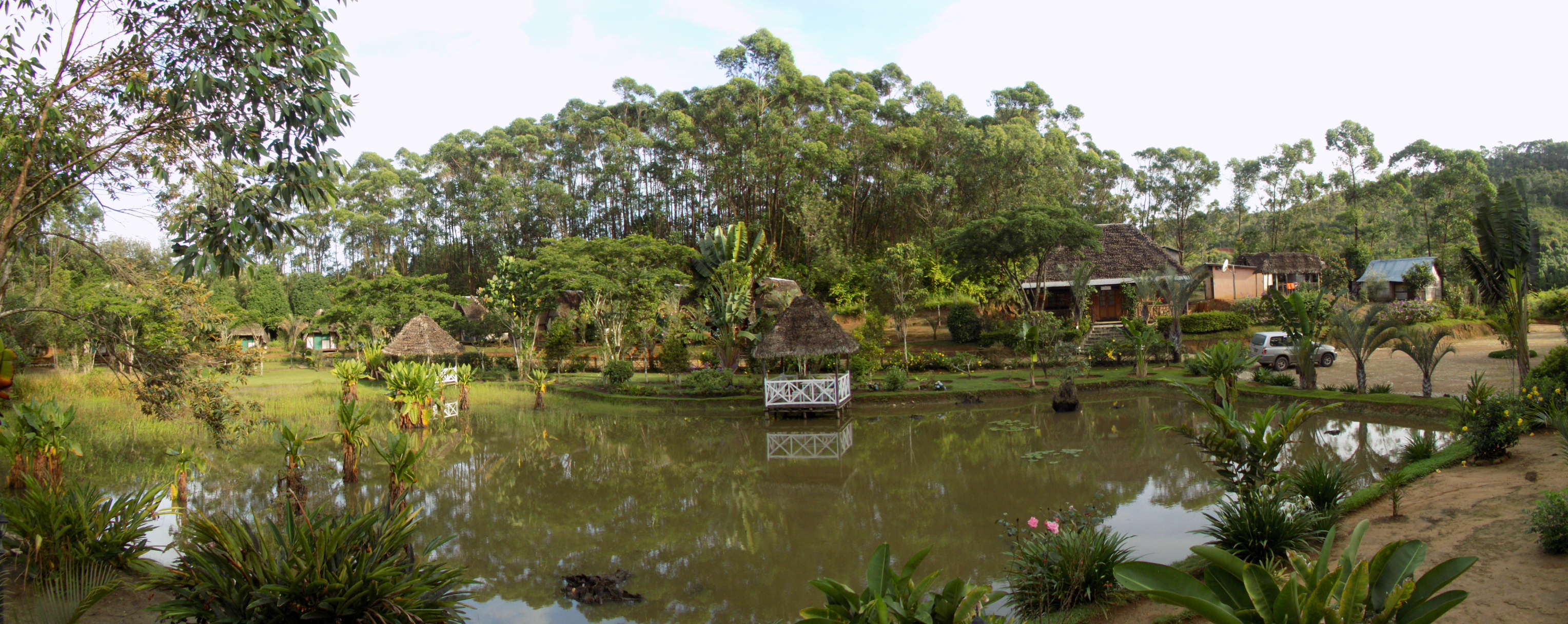
Like in many places throughout Madagascar here, too, we saw the traveller’s palm (Ravenala madagascariensis), a plant which in fact is not a palm at all, but that is its name. Over time it has been transferred to other parts of the world, but it is endemic on Madagascar and represents an important symbol of this country. This goes to such a degree that it is used as a symbol in the name and on the tail fin of the planes of the national air carrier.
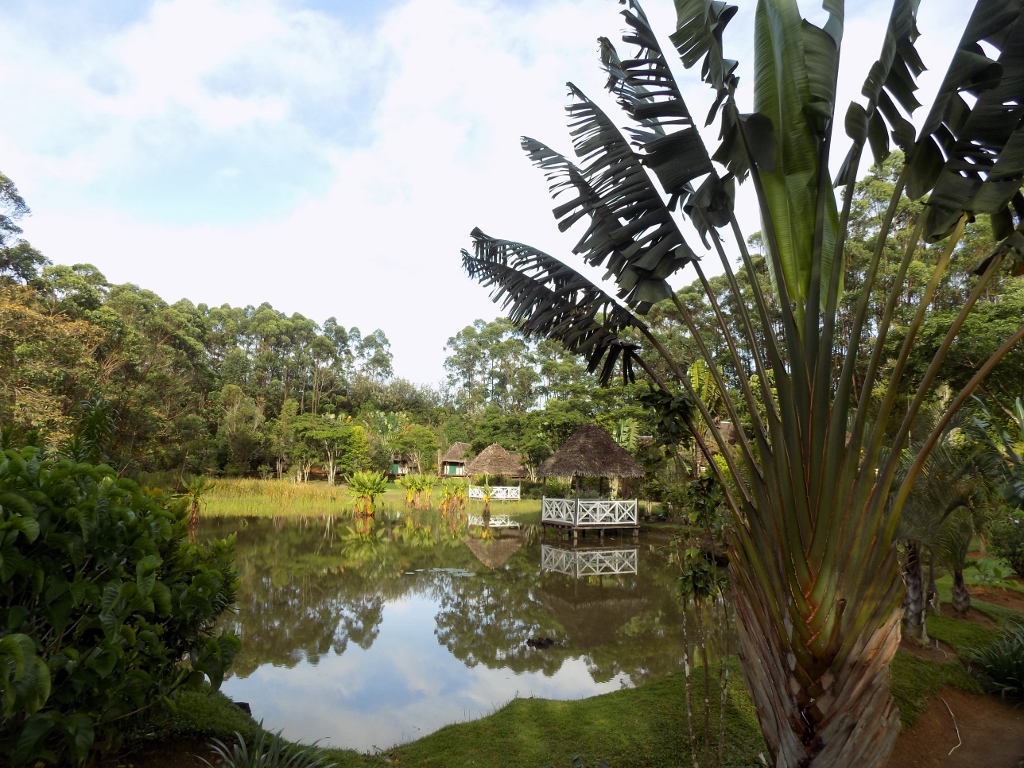 Traveller’s palm is on the right-hand side
Traveller’s palm is on the right-hand side
The reason for such a name of the plant is that it is said that in the base of the leaves it is possible to find large quantities of water and thus the travellers who get really thirsty can drink it. On the other hand, the data shows that water does collect there, but it is sufficiently dirty that it should not be drunk directly, i.e., without purification on any account.
After breakfast we drove to the entrance into the Analamazaotra Special Reserve which is a part of the Andasibe-Mantadia National Park. We bought the tickets there and Rija had already organised which guide was to go with us. This time it was Selena, while Sneža and I opted for a four-hour walk along the path that is called “Adventurous.” It sounded really good.
Without much ado, we started to go after Selena, first walking along a flat and wide path that led from the visitors’ centre and then uphill following a narrow path and entering deeper into the rainforest. Very soon we could hear the fantastic indri lemurs, but we could not see them. The sounds that they produce when calling one another are very strong and can be heard at the distance of 3 km. Here, you can have a listen:
Then we continued going through the rainforest by following a clearly established trail which had obviously been made there for visitors. At some point Selena told us we needed to get off the path and enter into the proper forest, since there in the treetops we could see the diademed sifakas (Propithecus diadema).
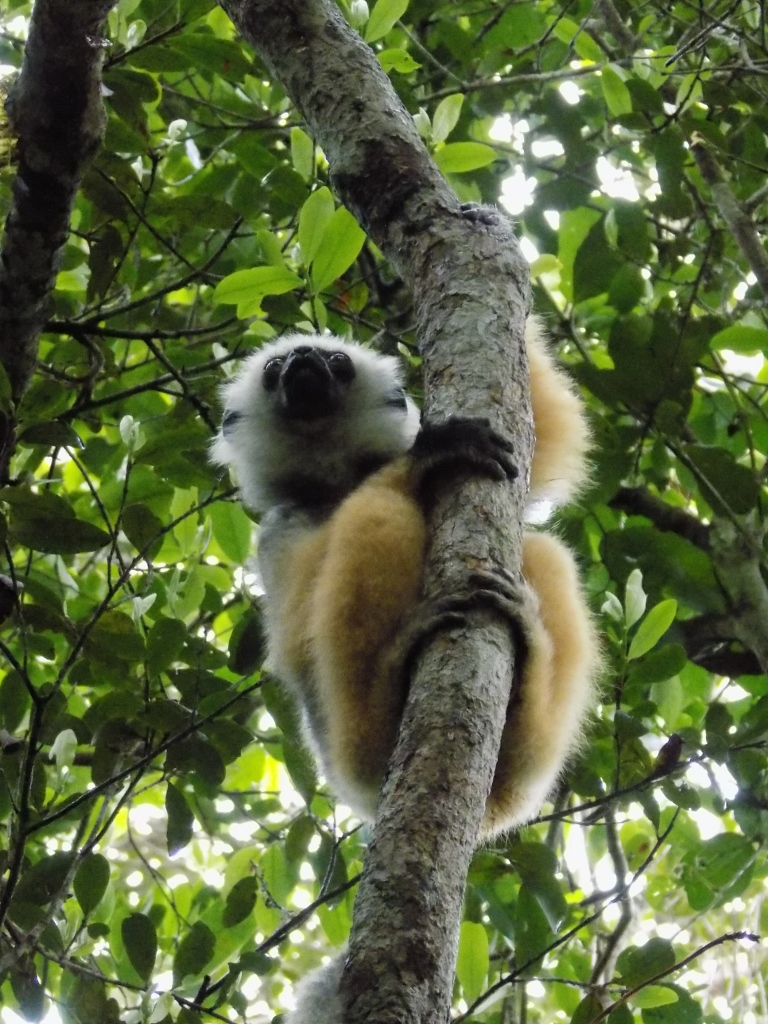 Diademed sifaka
Diademed sifaka
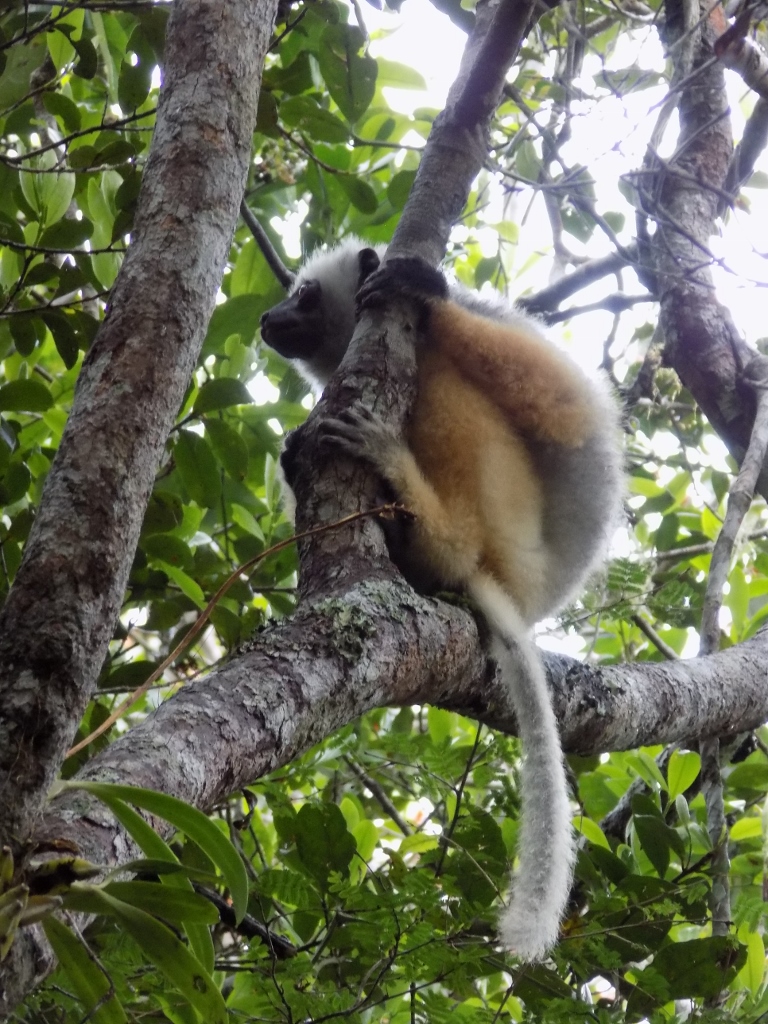 Diademed sifaka
Diademed sifaka
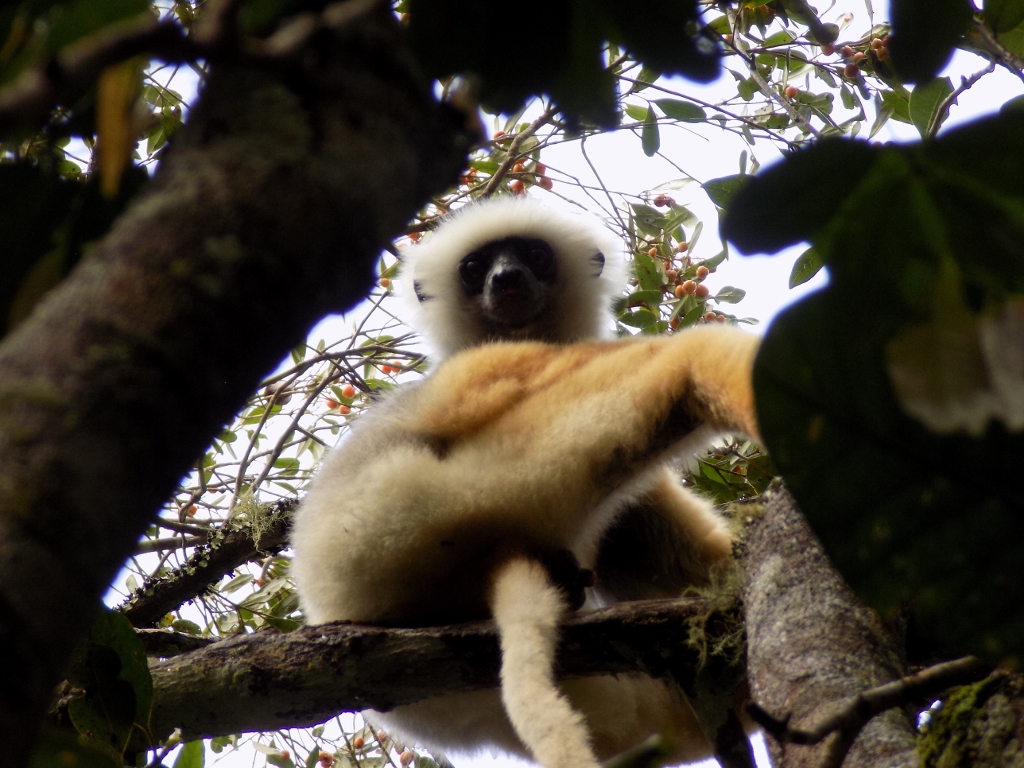 Diademed sifaka
Diademed sifaka
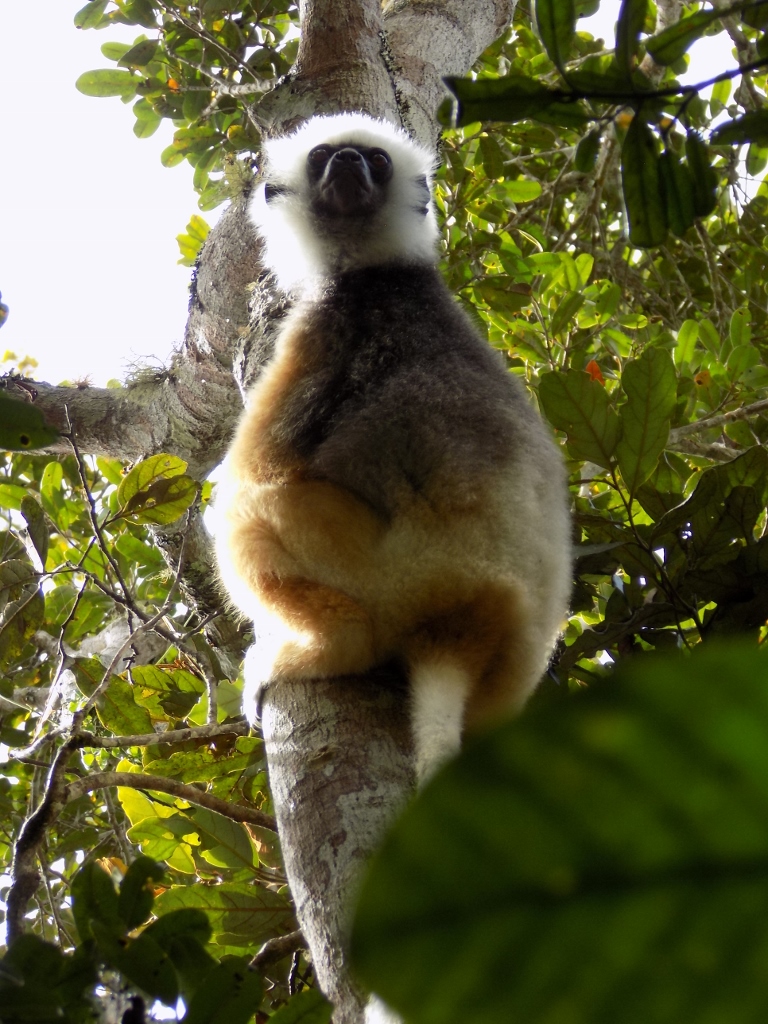 Diademed sifaka
Diademed sifaka
I caught one diademed sifaka with my photo-camera while it was holding on to a horizontal branch using only the fingers of its right foot, while the rest of its body extended downwards as it was trying to reach some berries it was feeding on.
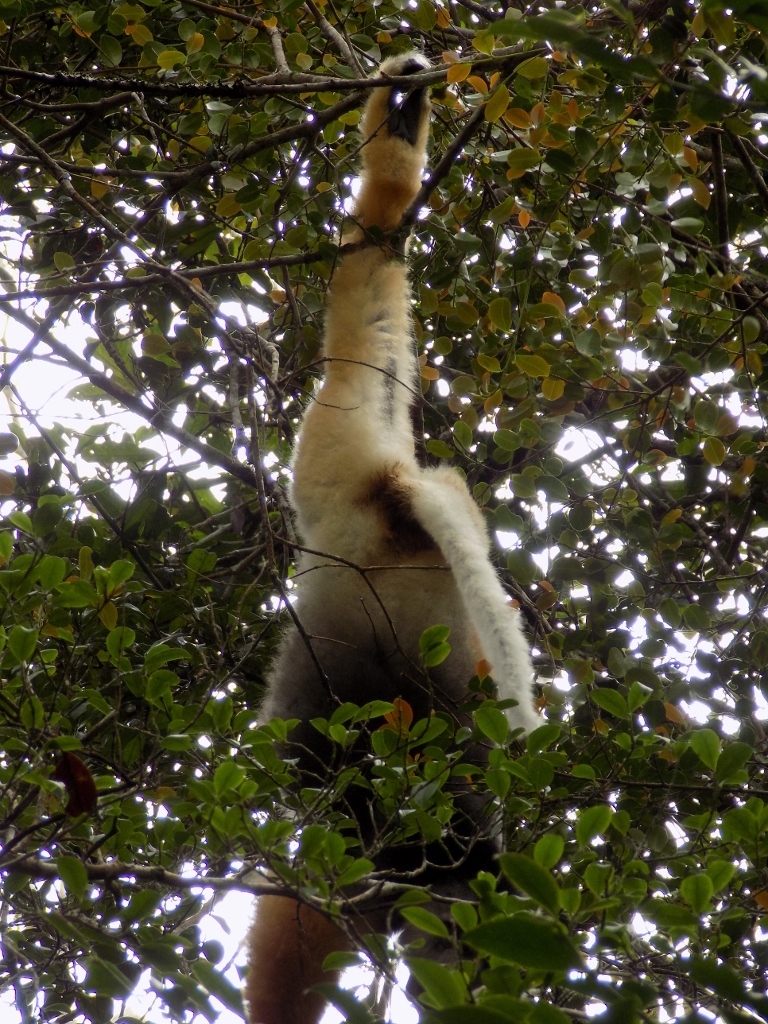 Diademed sifaka – the apex acrobat
Diademed sifaka – the apex acrobat
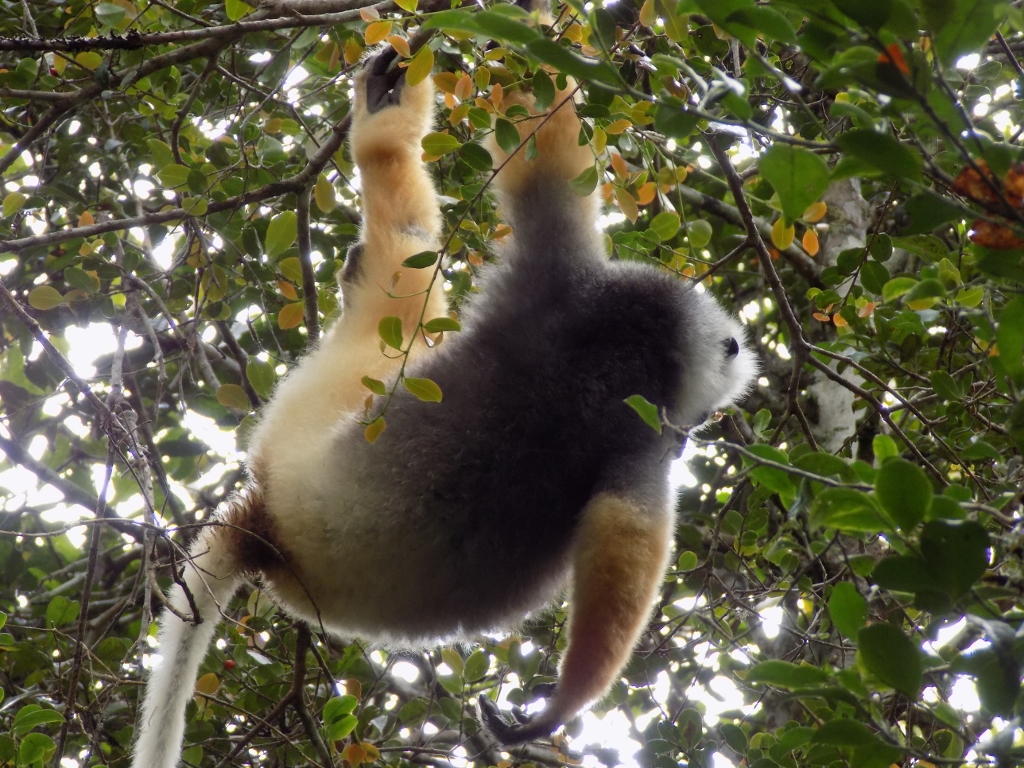 Diademed sifaka – now it is returning slowly back to the upper branch
Diademed sifaka – now it is returning slowly back to the upper branch
By the way, as far as I’ve got, sifakas are a type of lemurs who are more prone to standing somehow upright while in the treetops, they jump more and can cover with one jump the distance of as much as 10 metres. Also, when they move on the ground, they do this by standing completely upright, erected on their hind legs and moving sideways, on account of which they are also called the dancing lemurs. We did not see them on the ground, but even like this, in the treetops, they were very interesting. You can also hear the sounds of the rainforest here:
After some time spent watching the diademed sifakas, we returned to the path and now we mostly walked over flat terrain.
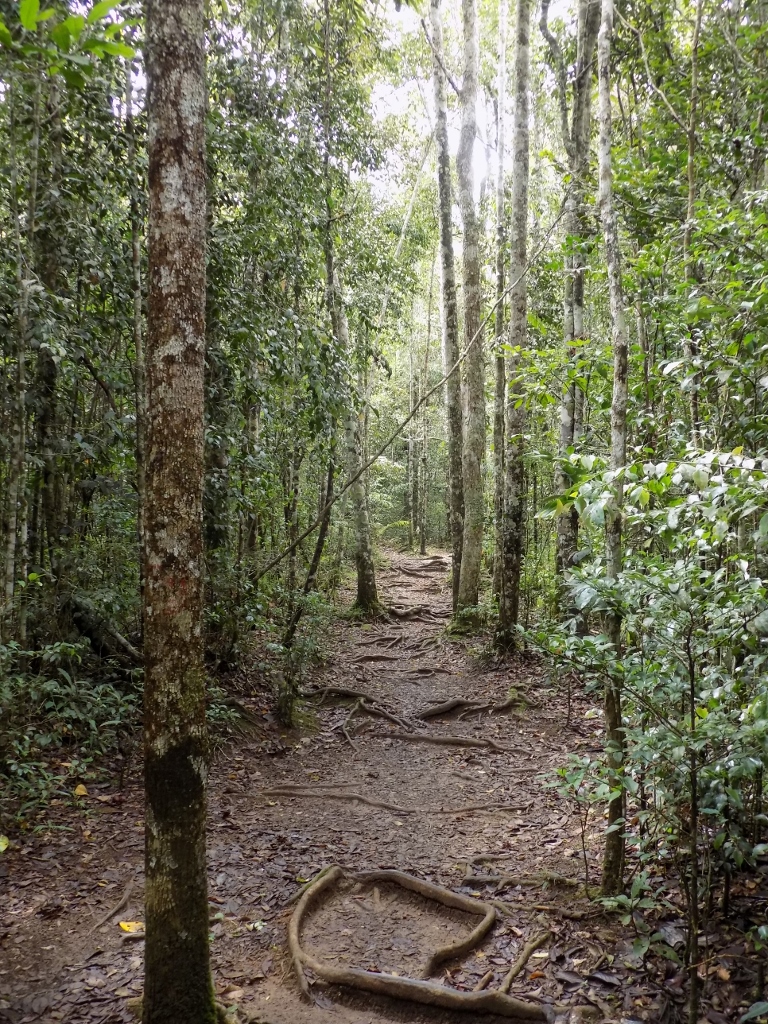 Path in the Analamazaotra Special Reserve
Path in the Analamazaotra Special Reserve
When you walk through a rainforest like this, in addition to hearing different sounds, it is also possible to see a multitude of life in different forms. Among others, we also saw a tiny orchid. A special season in this reserve is during October and November when orchids are in their full bloom and according to our guide they are abundant here.
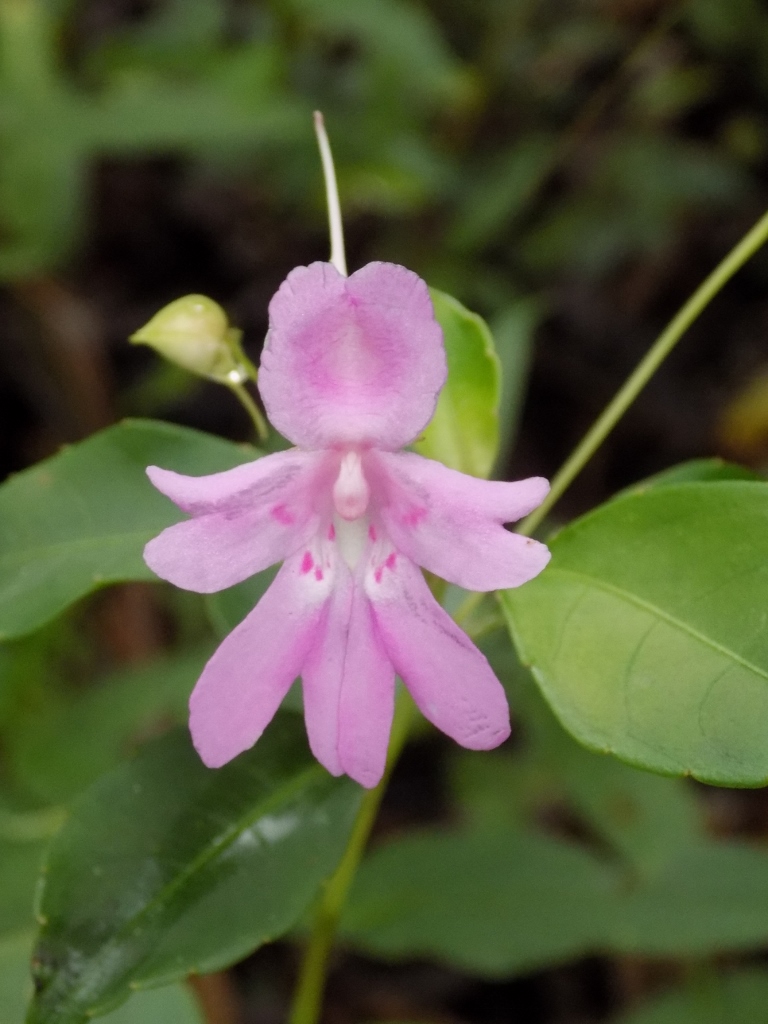 Tiny little orchid
Tiny little orchid
But, there were different fungi here, too, as well as unusually big snails and other invertebrates.
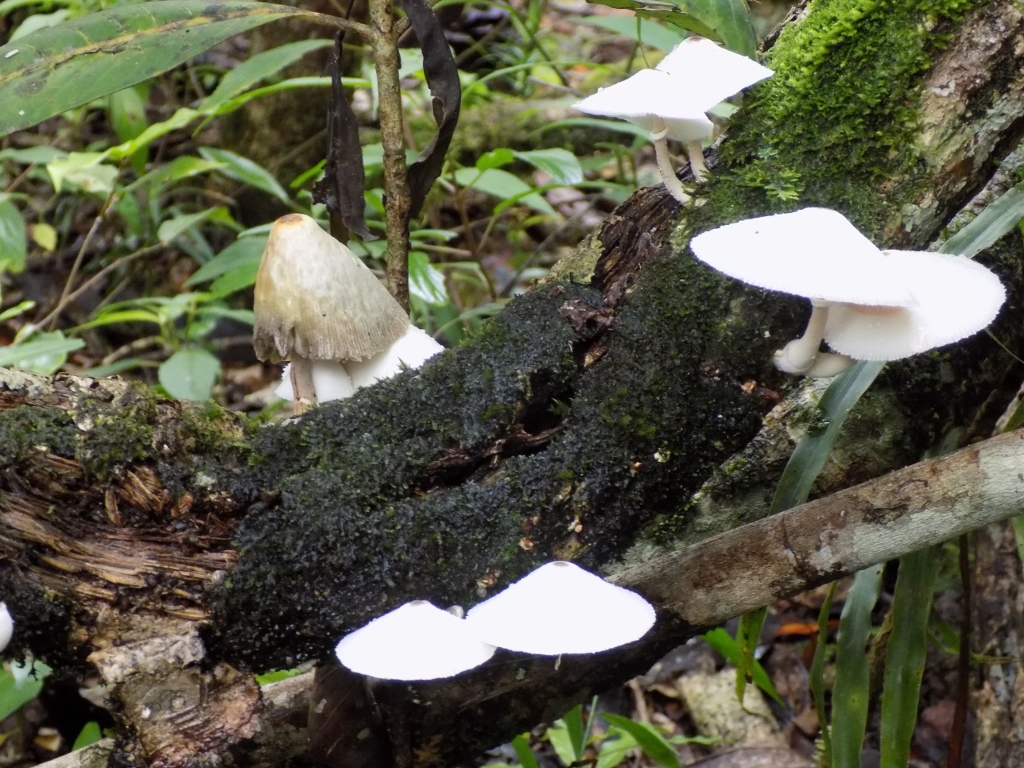 One of the large number of different fungi
One of the large number of different fungi
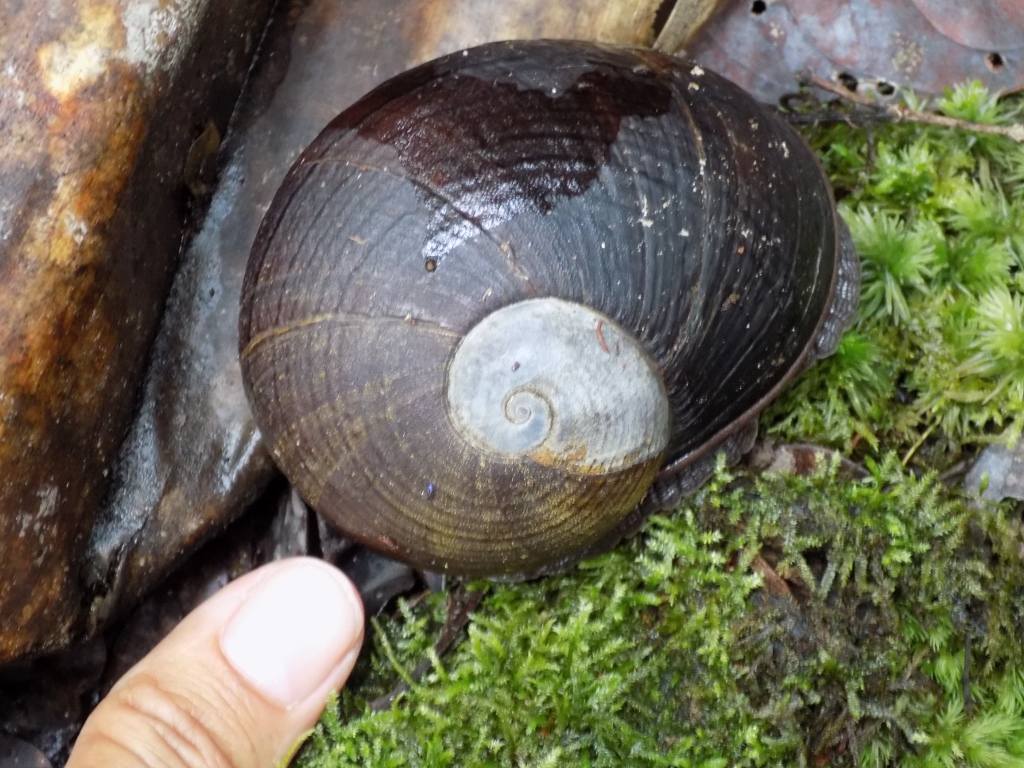 My thumb and a snail
My thumb and a snail
Still, we continued being mostly focused on finding lemurs.